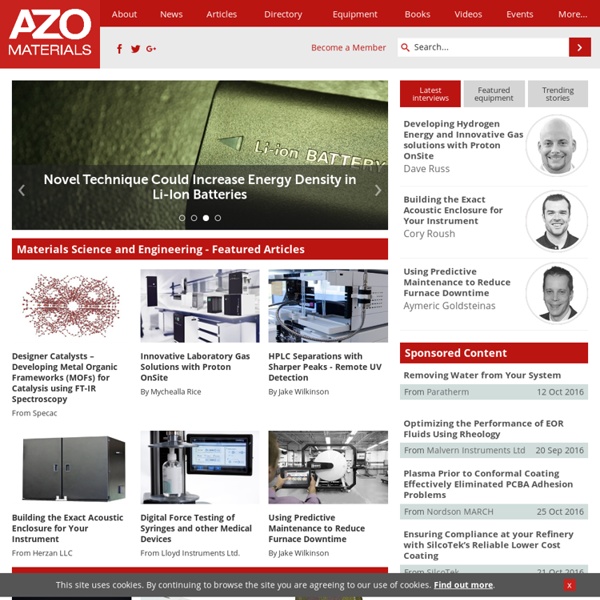



An Error Occurred Setting Your User Cookie This site uses cookies to improve performance. If your browser does not accept cookies, you cannot view this site. Setting Your Browser to Accept Cookies There are many reasons why a cookie could not be set correctly. Below are the most common reasons: You have cookies disabled in your browser. FAQ: What are the microstructural constituents Austenite, Martensite, Bainite, Pearlite and Ferrite? Frequently Asked Questions Austenite and ferrite Austenite was originally used to describe an iron-carbon alloy, in which the iron was in the face-centred-cubic (gamma-iron) form. It is now a term used for all iron alloys with a basis of gamma-iron.
MATTER: Who we are MATTER was set up as a non-profit consortium of UK materials science departments in 1993 to develop and help integrate computer-based learning (CBL) materials into mainstream teaching. Led by the University of Liverpool, MATTER was originally one of over 70 different projects funded by the Teaching and Learning Technology Programme (TLTP). This phase of the project resulted in the publication in 1996 of the award-winning Materials Science on CD-ROM, with a second version being released in 1998. CRYSTALS » Chemical Crystallography CRYSTALS is a software package for single crystal X-ray structure refinement and analysis. The download contains CRYSTALS , Cameron and specially recompiled versions of SIR92 and SHELXS. There are also transparent links to SUPERFLIP (Lucas Palatinus’s structure solution by charge flipping), MCE (a Fourier map and voids viewer by Rohlicek & Husak) both of which are distributed with CRYSTALS. There are links to PLATON for structure validation and for SQUEEZing disordered regions.
JMatPro Thermo-physical & physical properties bespoke software UK Sente Software Ltd. JMatPro® is a simulation software which calculates a wide range of materials properties for alloys and is particularly aimed at multi-components alloys used in industrial practice. Using JMatPro you can make calculations for: Stable and metastable phase equilibrium Solidification behaviour and properties Mechanical properties Thermo-physical and physical properties Phase transformations Chemical properties JMatPro includes a Java based user interface, with calculation modules using C/C++, and will run under any Windows OS (at least Windows 98). It will also run on multi-core machines with 32/64 bits OS. JMatPro has been designed so that it can be used by any engineer or scientist that requires materials properties as part of their everyday work.
What can I do with a material science/technology degree? A materials science/technology degree course opens doors to jobs in a range of industries, and provides knowledge of manufacturing, processing and the fabrication of materials Job options Jobs directly related to your degree include: Jobs where your degree would be useful include: Iron pillar of Delhi The Iron Pillar located in Delhi, India, is a 7 m (23 ft) column in the Qutb complex, notable for the rust-resistant composition of the metals used in its construction. The pillar has attracted the attention of archaeologists and materials scientists and has been called "a testament to the skill of ancient Indian blacksmiths" because of its high resistance to corrosion.[1] The corrosion resistance results from an even layer of crystalline iron hydrogen phosphate forming on the high phosphorus content iron, which serves to protect it from the effects of the local Delhi climate.[2] The pillar weighs over 6,000 kg, and is thought to have originally been erected in what is now Udayagiri by one of the Gupta monarchs in approximately 402 CE, though the precise date and location are a matter of dispute.[3] It was transported to its current location in 1233 CE.[4] Description The Iron pillar stands within the courtyard of Quwwat-ul-Islam Mosque
The Trinity explosion 0.016 seconds after detonation, 1945 The Trinity explosion, 16 ms after detonation. The viewed hemisphere’s highest point in this image is about 200 metres (660 ft) high. On July 16, 1945, the United States became the first country to successfully detonate an atomic weapon, signalling the beginning of a new era in warfare and in politics. In the early 1940s, the U.S. government authorized a top-secret program of nuclear testing and development, codenamed “The Manhattan Project”. EFM 1: Mass Transfer and Diffusion Material used by Prof. Jirka (pdf) Course Script (Textbook)